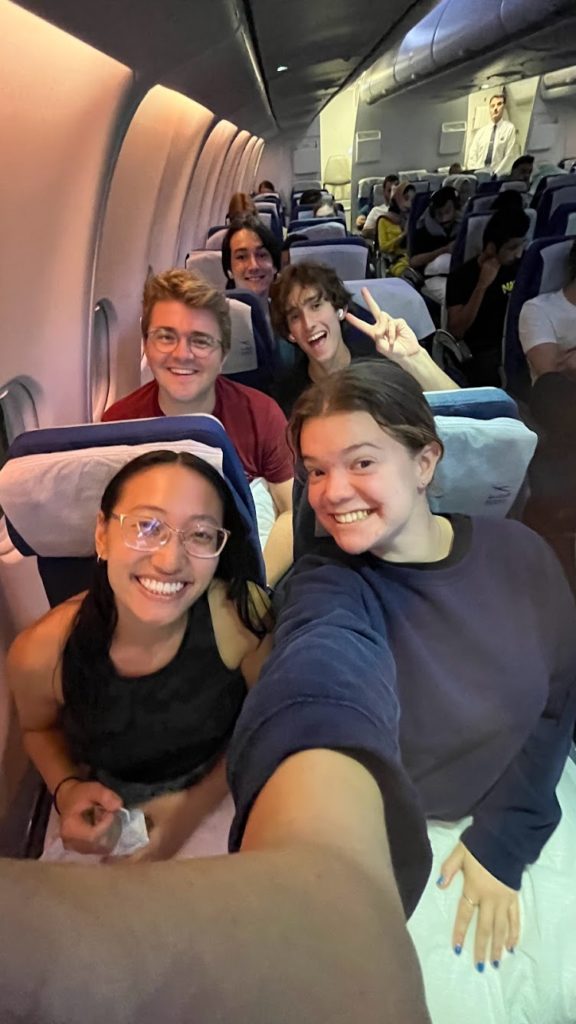On paper, a month can sound like a long time, but based on how fast my time in Morocco flew, I was determined to squeeze every last drop out of my month ahead in Nepal right from the moment our plane landed, and fortunately our orientation gave us an exciting insight for just how much this country had in store for us. After a winding bus ride up the hillside out of Kathmandu at 3:00 am, we were greeted with hearty bowls of soup at a resort in Nagarkot where we were to spend a few days resting and getting oriented. Besides catching up on sleep, I used this time to reset my mind and body with long walks (including a cloudy hike-turned-run-in-the-rain with friends), yoga sessions overlooking Kathmandu valley, and organizing my plans, assignments, and fun activities for the month ahead.

After our few days long retreat up in the hills, we took a winding bus ride down into Kathmandu valley to begin the next leg of our time in Nepal. For our time in the city I was paired with my sweet friend Jaime as a homestay buddy, and placed with a Newari family made up of a host mom and dad, our 19 year old host sister, and our 10 year old host brother. The home is six stories tall (meaning we have quite the hike to our room on the fifth floor) with a rooftop terrace that makes for great views of the city (and even the Himalayas on a clear day!). In the spirit of seizing the day, I spent my first full day exploring the city by checking out the farmers market, trying some yummy veggie momos, stopping by a film festival, and getting the most incredible Ayurvedic massage at my first ever spa.
The following day Jaime and I switched to a more cultural and historic focus by spending the morning exploring Patan Durbar Square nearby our home. The square is packed full of historic temples, buildings, sculptures, and art, all with a rich, lengthy history. What stood out most to me was the concept of “living history” in how despite the great age of these structures and the massive destruction they’ve faced from earthquakes over the years, they still are well preserved. Communities have prioritized their upkeep through the generations and still see as much cultural value in them even when they are totally destroyed and must be rebuilt, which I think is really beautiful. In the afternoon we had our renowned guest lecturer take us along the river and to the Boudha Stupa temple and nearby monastery to learn about water and city planning, Buddhism, and culture.
A short bout of sickness put me out of commission for the next few days, but once I felt better I immediately jumped back into exploring by checking out a local art gallery, visiting the so-called “monkey temple” (which was indeed full of monkeys, some a little too friendly) and watching the sun set over the city, and enjoying some live jazz with friends into the night.
The first of two excursions of the month was to the Terai lowlands, a region that paints a very different picture of Nepal than the typical mountainous perception that comes to mind. Full of waving plains of rice and rhino-filled jungles, the lowlands were a long, winding, bumpy seven hour bus ride out from the city. We spent the next couple days learning about the history of conservation, human-wildlife conflict, and research ethics. By interacting with the gracious local community, we learned how to harvest rice, came to better understand the impacts of nearby Chitwan National Park, and experienced a beautiful cultural dance performance. My favorite part of the excursion was without a doubt the safari, where we saw wild rhinos, peacocks, endangered crocodiles, and more, which we followed up with some community building on the riverside as dusk settled over the lowlands (see picture of our impressive human pyramid).
After an equally bumpy bus ride back out of the lowlands into the city, we were given the following two days to rest up and enjoy the nationwide holiday for the Dashain Festival, an extensive religious holiday celebrating good harvest and worshipping certain religious deities. To celebrate, Jaime and I learned (rather unsuccessfully) how to fly kites over the city with our homestay family, dressed up in traditional Nepali clothing, and went with our homestay sister to get a blessing from the kumari, or living goddess — an important religious figure in the Nepali Newari Buddhist community.
Needless to say, I think I’ve been doing well on my intent to squeeze everything I can out of this month. I would be remiss, however, to gloss over the moments of rest and peace during these two weeks. All good adventures must be balanced out with restoration of the mind and body, and living in a majority Hindu country that places such high value on this has made this quite opportune for me. Remembering to take rests is something I must constantly remind myself of, but I’ve found that being in Nepal has made it easier for me to find these moments of peace, whether it’s through a yoga class, during a meditation in the morning, when reading outside in the courtyard, or while enjoying all the stunning nature. As with all things in life, walking this line between rest and adventure is a delicate balance, but a journey worth every second.